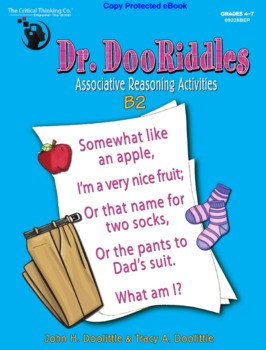Dr. DooRiddles B2: Associative Reasoning Activities for Grades 4-7
- PDF
Description
This 60-page printable PDF ebook is packed full of brain-scratching riddles that develop students' fluency and understanding of word meanings and associations. These riddles also develop spelling, vocabulary, reading, critical thinking and creative problem-solving skills.
Everyone loves the mystery of a riddle and Dr. DooRiddles will bring laughter, groans,
and challenges (perhaps for as much as a week or more per riddle) to you and your
students.
Perceiving relationships between words, ideas, and concepts is called associative reasoning, which is a skill necessary for creative thought. Riddle solving requires students to use important skills of associative, inductive, and divergent thinking to find the answers. Students will learn to recognize important ideas, examine these ideas from different points of view, and then find connections between the ideas. These teachable skills are essential for efficient, successful, open-ended problem-solving of all kinds.
Although Dr. DooRiddles are fun and tantalizing, answering them is not simple play. In order to solve these riddles, students have to generate solutions in many different categories. Students often confuse multiple-category generation of answers with offering the same answer rephrased. To clarify this confusion, students need to learn how to examine an idea from many reference points.
Students should be encouraged to read the riddles, examining the sound of each line and individual words, and to use visual imagery to “see” what’s happening. As they get into the process of riddle solving, they will learn to read and weigh the importance of each word in each line so they can interpret the clues correctly. They will learn to notice how highly descriptive adjectives, verbs, and adverbs indicate specific kinds of movement or action; and how unusual phonetic spellings, homonyms, prefixes, suffixes, roots, puns, analogies, and multiple word meanings are used to both hide and reveal the clues.
These materials make great sponge activities and are excellent activities for independent, cooperative, or open learning situations. The riddles can be used as part of the daily thinking skill curriculum or for the challenge of the week. The riddles spiral up in difficulty within each book and from level to level so that teachers may select the appropriate level of difficulty for students.
Dr. DooRiddles cuts across curriculum areas and deals with real-world objects and situations. Both teachers and students will find the mind-broadening strategies used in these challenging activities richly rewarding at test-taking time.
This book includes practice activities, suggestions, and answers.
---------------------------------------
Written by John H. Doolittle & Tracy A. Doolittle
///////////////////////////////
Click Here for more Dr. DooRiddles activities!



